CHEVROLET EXPRESS 1996 1.G User Guide
Manufacturer: CHEVROLET, Model Year: 1996, Model line: EXPRESS, Model: CHEVROLET EXPRESS 1996 1.GPages: 376, PDF Size: 18.83 MB
Page 11 of 376
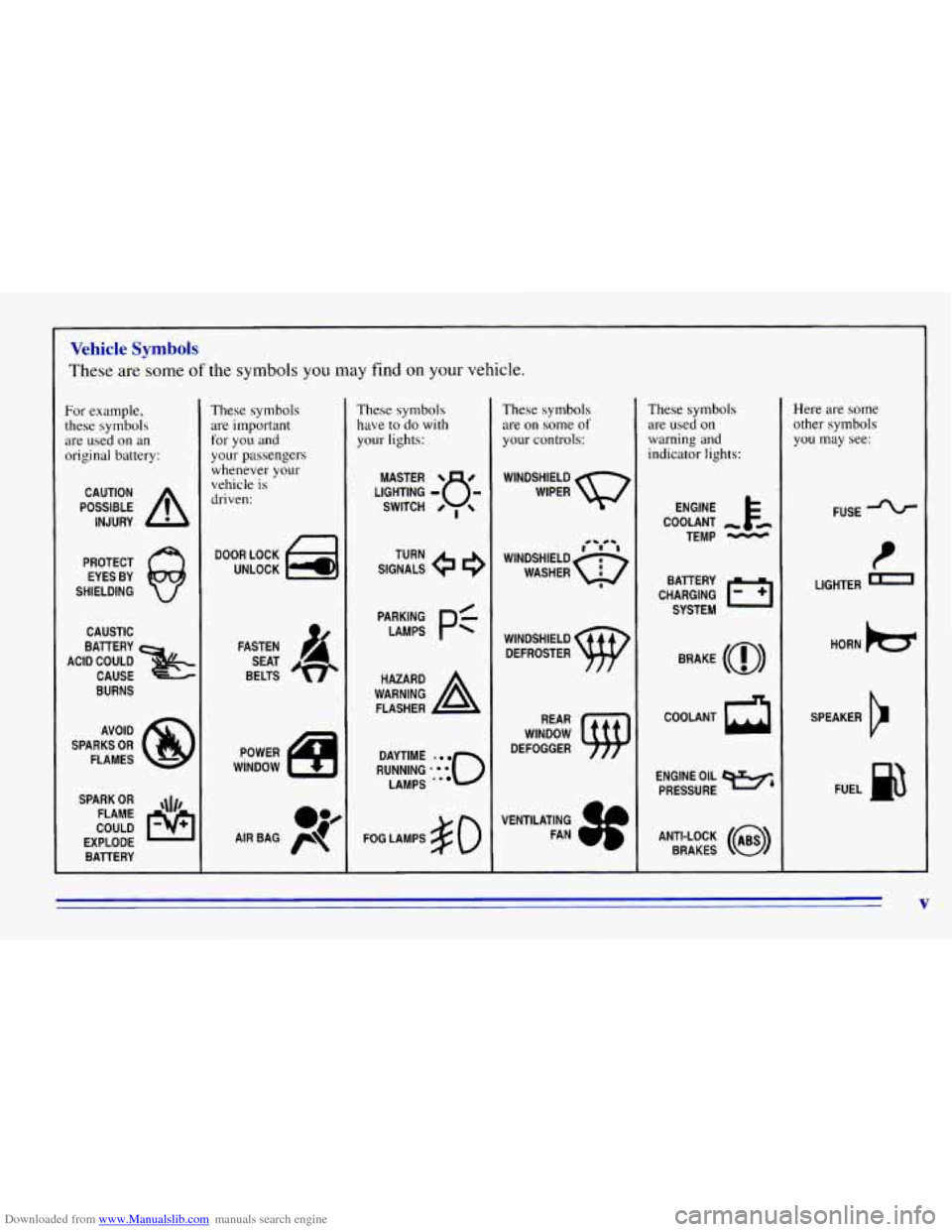
Downloaded from www.Manualslib.com manuals search engine Vehicle Symbols
These are some of the symbols you may find on your vehicle.
For example,
these symbols
are used
on an
original battery:
POSSIBLE A
CAUTION
INJURY
PROTECT EYES BY
SHIELDING
CAUSTIC
ACID COULD BATTERY
CAUSE
BURNS
SPARK
OR ,\I/,
COULD FLAME
EXPLODE BATTERY
These symbols
are important
for
you and
your passengers
whenever your
vehicle
is
driven:
DOOR LOCK
UNLOCK
FASTEN SEAT
BELTS
These symbols have to do with
your lights:
SIGNALS e e
TURN
RUNNING
-0
DAYTIME
LAMPS -*
FOG LAMPS # 0
These symbols
are on some of
your controls:
WINDSHIELD
DEFROSTER
VENTILATING FAN
These symbols
are used on
warning and
indicator lights:
COOLANT -
TEMP -
CHARGING BATTERY
SYSTEM
BRAKE
(0)
COOLANT a
ENGINE OIL e,
PRESSURE
ANTI-LOCK
(@)
BRAKES
Here are some
other symbols
you may see:
FUSE
t
LIGHTER -
HORN )tr
SPEAKER
b
FUEL m
V
Page 12 of 376
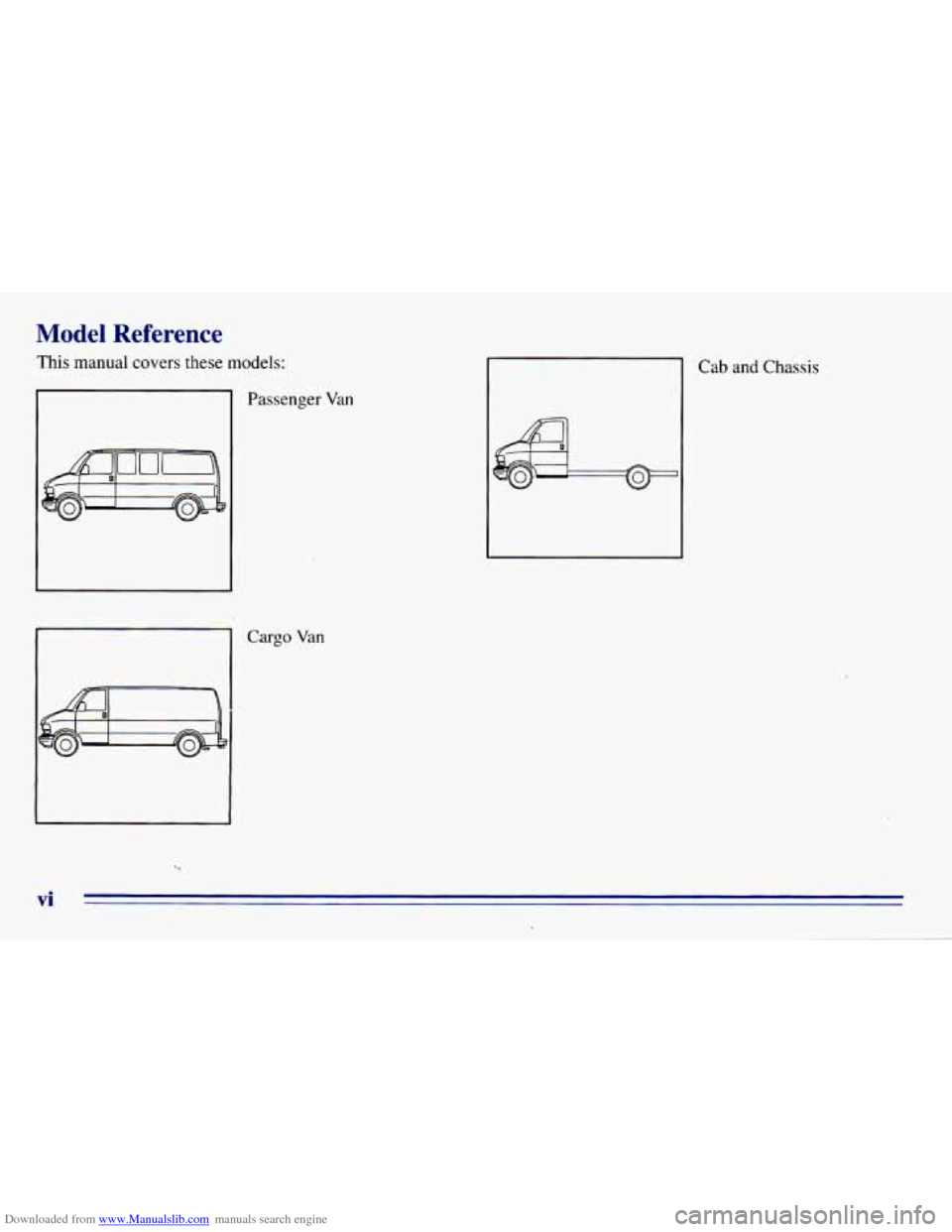
Downloaded from www.Manualslib.com manuals search engine Model Reference
This manual covers these models:
vi
Passenger Van
Cargo Van 1
Cab and Chassis
Page 13 of 376
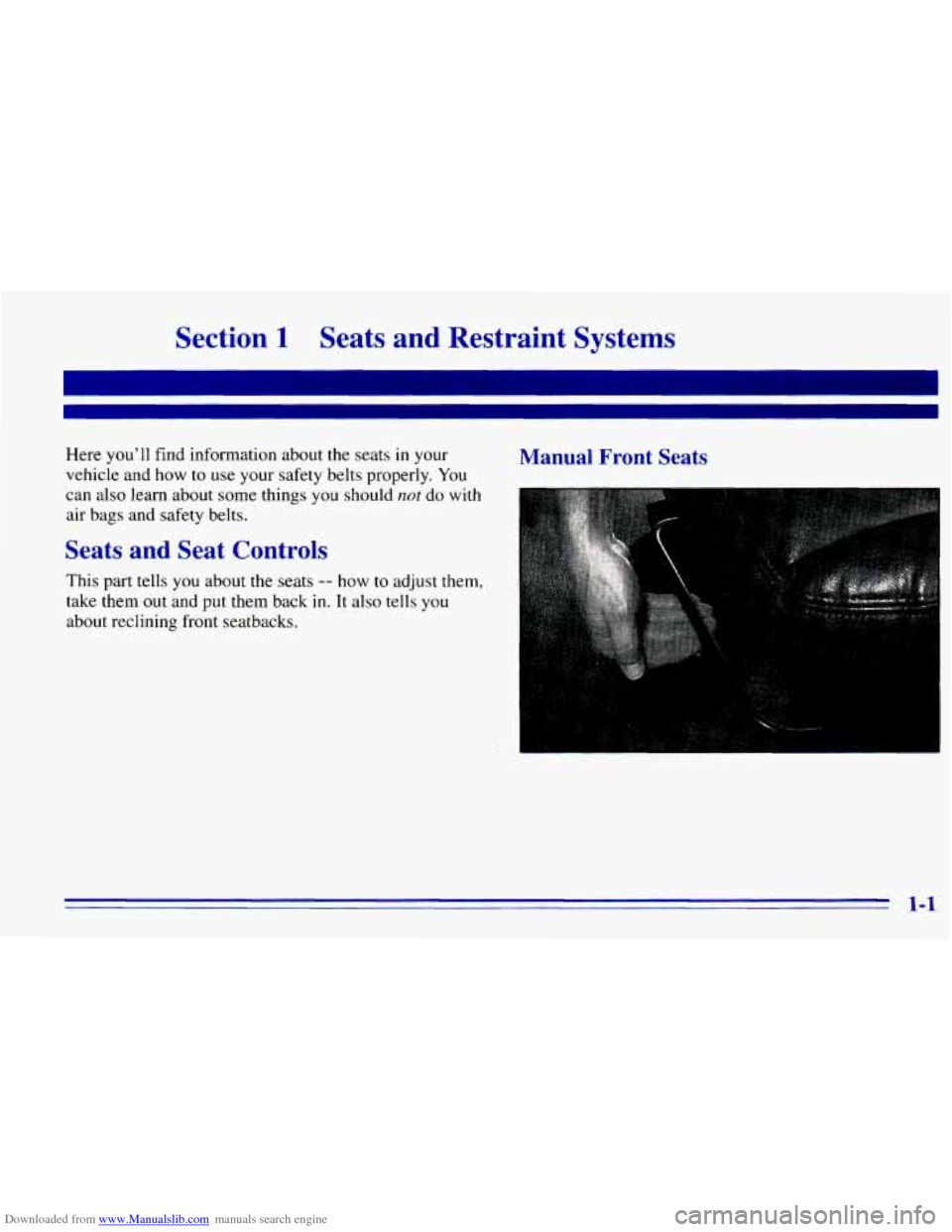
Downloaded from www.Manualslib.com manuals search engine Section 1 Seats and Restraint Systems
Here you'll find information about the seats in your
vehicle and how to use your safety belts properly. You
can also learn about some things you should
nut do with
air bags and safety belts.
Seats and Seat Controls
This part tells you about the seats -- how to adjust them,
take them out and
put them back in. It also tells you
about reclining front seatbacks.
Manual Front Seats
1-1
Page 14 of 376
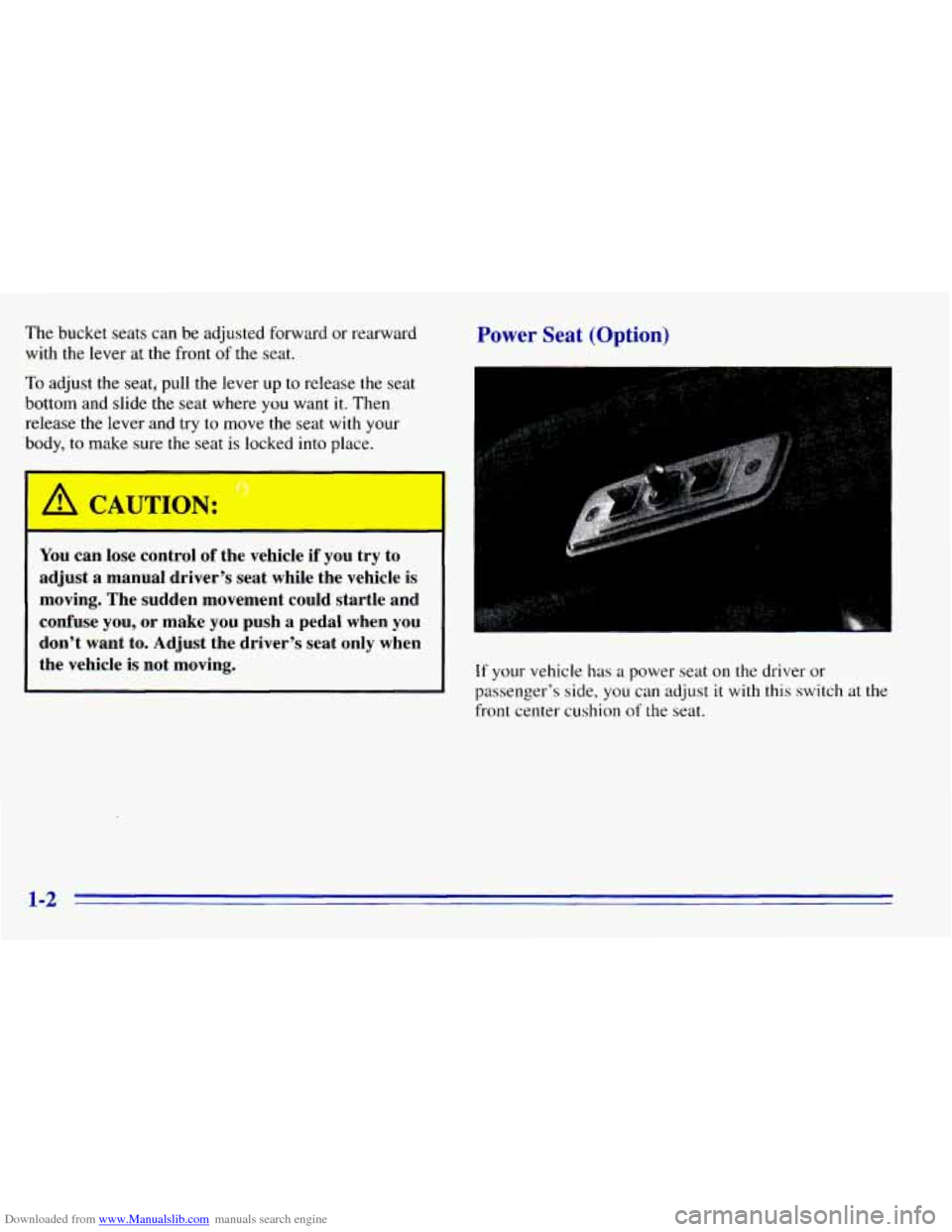
Downloaded from www.Manualslib.com manuals search engine The bucket seats can be adjusted forward or rearward
with the lever at the front
of the seat.
To adjust the seat, pull the lever up to release the seat
bottom and slide the seat where
you want it. Then
release the lever and try to move the seat with
your
body, to make sure the seat is locked into place.
’
A CAUTION:
You can lose control of the vehicle if you try to
adjust a manual driver’s seat while the vehicle is
moving. The sudden movement could startle and
confuse
you, or make you push a pedal when you
don’t want to. Adjust the driver’s seat only when
the vehicle
is not moving.
Power Seat (Option)
I
I
If your vehicle has a power seat on the driver or
passenger’s side, you
can adjust it with this switch at the
front center cushion
of the seat.
1-2
Page 15 of 376
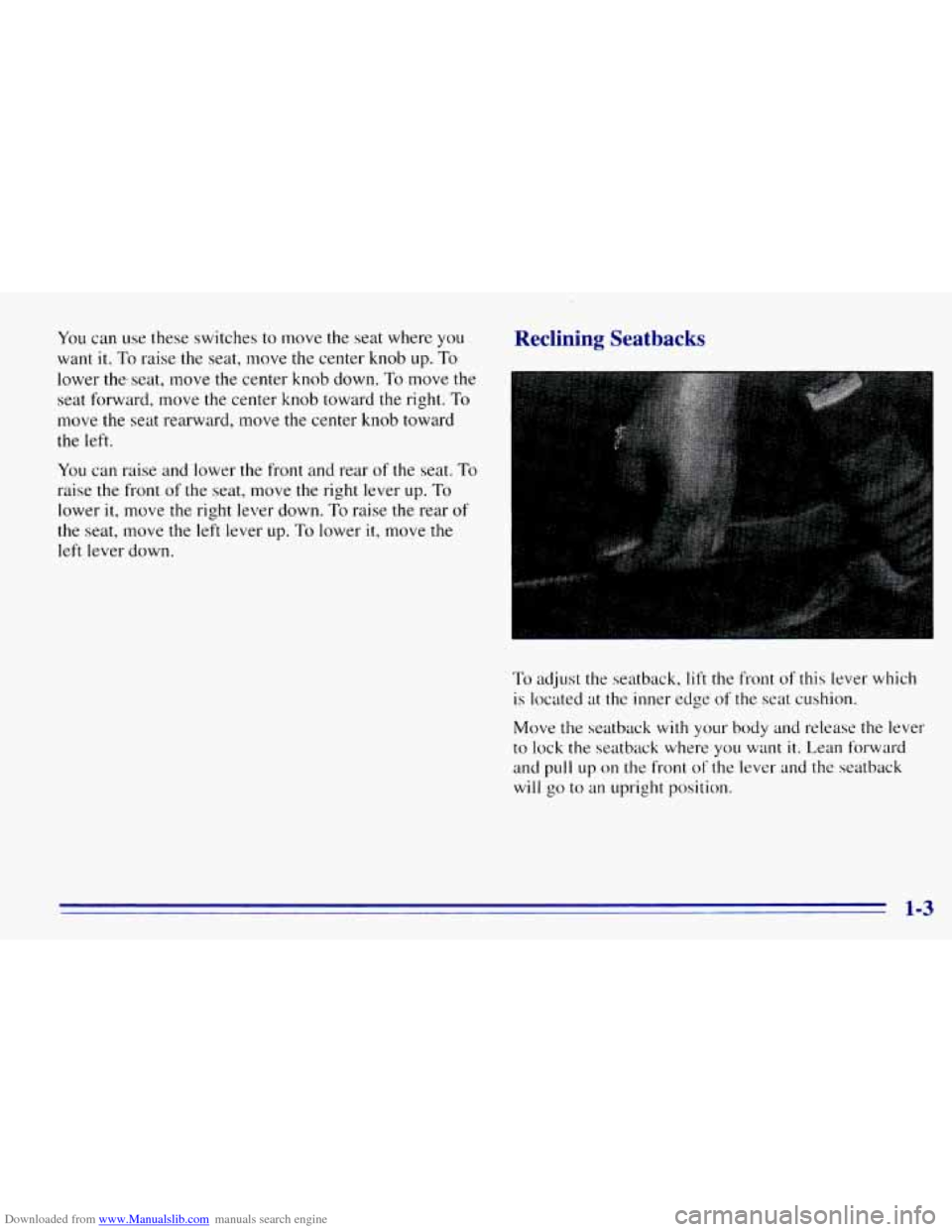
Downloaded from www.Manualslib.com manuals search engine You can use these switches to move the seat where you
want it. To raise the seat, move the center knob up. To
lower the. seat, move the center knob down. To move the
seat forward, move the center knob toward the right.
To
move the seat rearward, move the center knob toward
the left.
You can raise and lower the front and rear of the seat. To
raise the front of the seat, move the right lever up. To
lower it, move the right lever down. To raise the rear of
the seat, move the left lever up. To lower it, move the
left lever down.
Reclining Seatbacks
To adjust the seatback, lift the front of this lever which
is located
at the inner edge of the. seat cushion.
Move the
seatback with your body and release the lever
to lock the seatback where yo11 want it. Ixan forward
and pull up on the front of' the lever and the seatback
will
go to an upright position.
1-3
Page 16 of 376
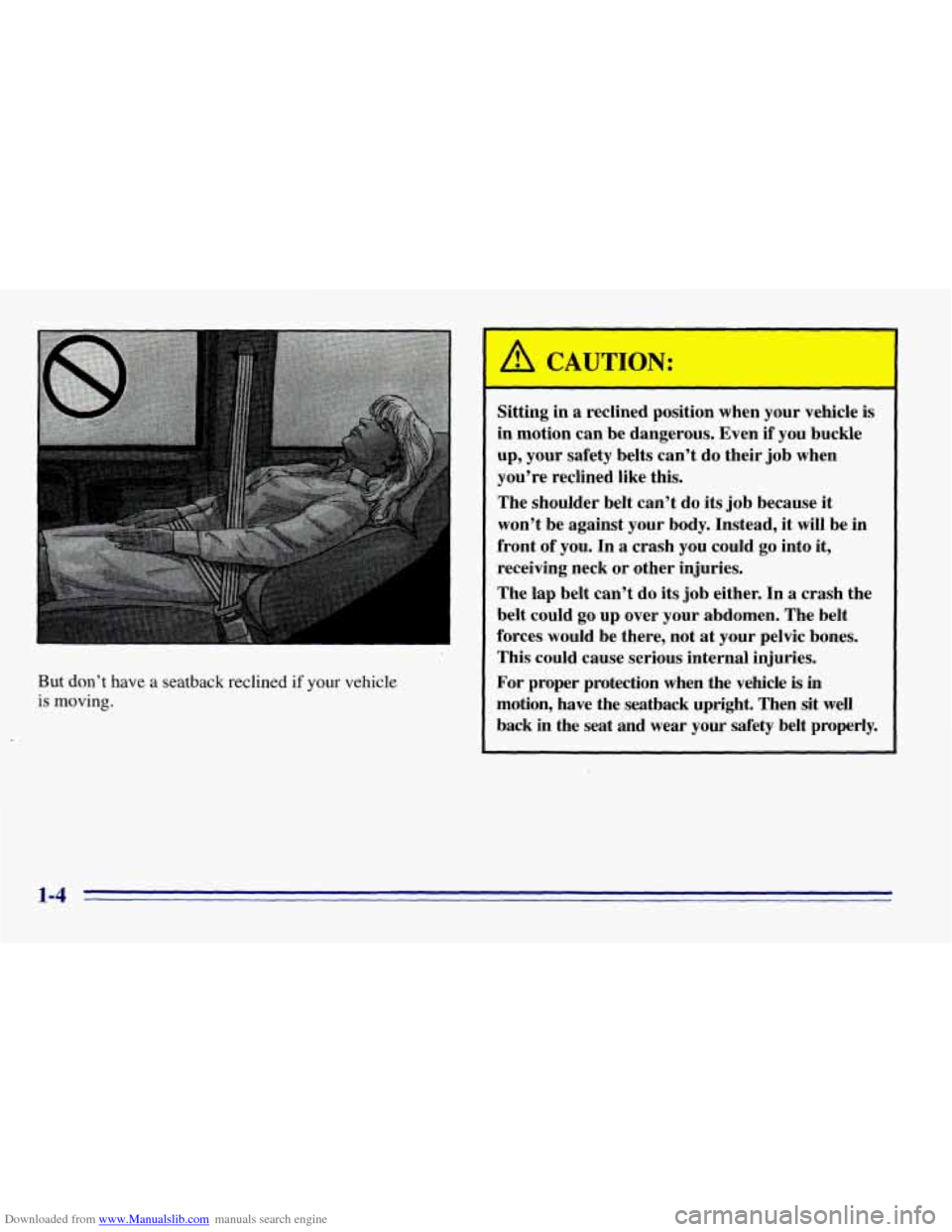
Downloaded from www.Manualslib.com manuals search engine But don’t have a seatback reclined if your vehicle
is moving.
A CAUTION:
Sitting in a reclined position when your vehicle is
in motion can be dangerous. Even if you buckle
up, your safety belts can’t do their job when
you’re reclined like this.
The shoulder belt can’t do its job because it
won’t be against your body. Instead, it will be in
front of you. In a crash
you could go into it,
receiving neck or other injuries.
The lap belt can’t
do its job either. In a crash the
belt could go up over your abdomen. The belt
forces
would be there, not at your pelvic bones.
This could cause serious internal injuries.
For proper protection when the vehicle is in
motion, have the seatback upright. Then sit well
back in the seat and wear your safety belt properly.
1-4
Page 17 of 376
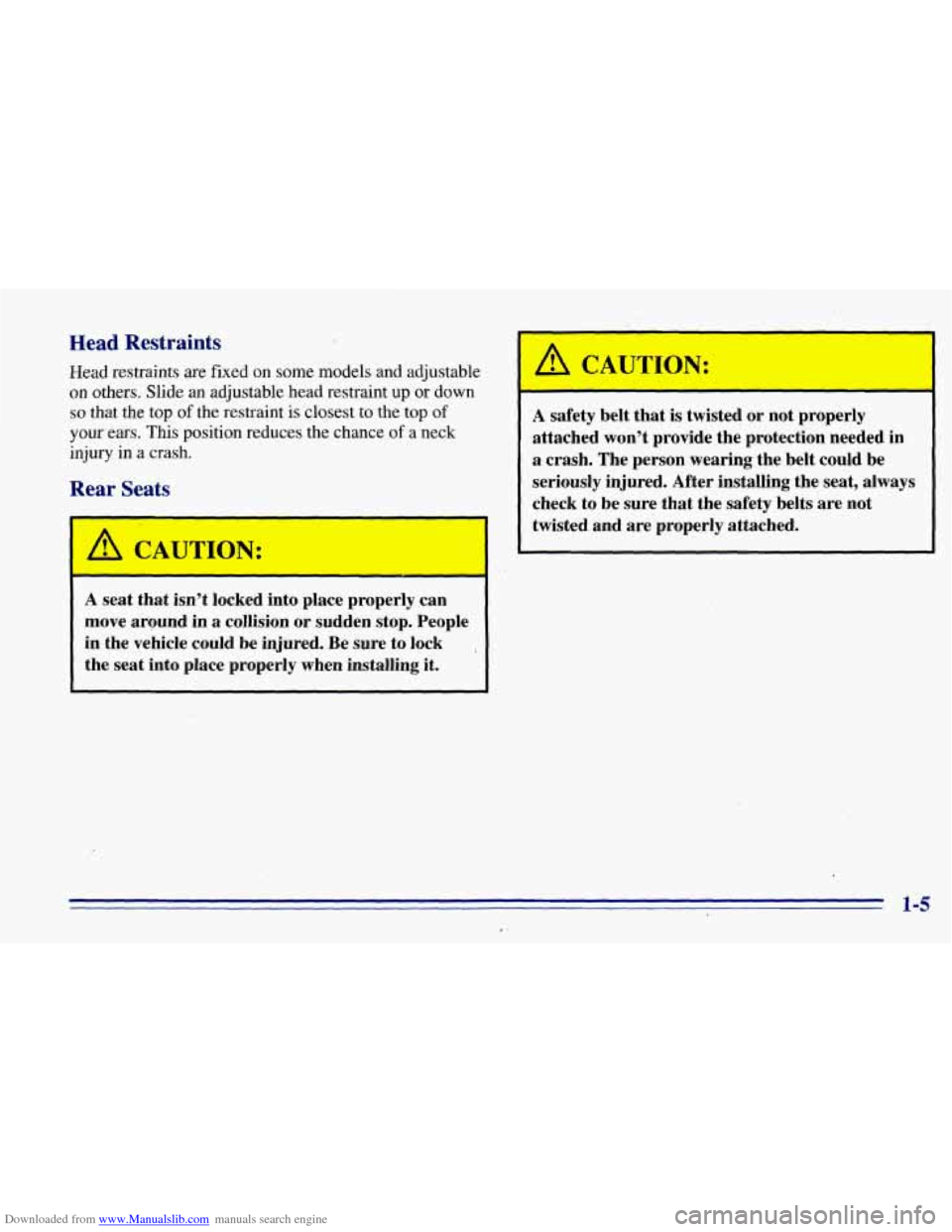
Downloaded from www.Manualslib.com manuals search engine Head Restraints
Head restraints are fixed OB some models and adjustable
on others. Slide
an adjustable head restraint up or down
so that the top of the restraint is closest to the top of
your ears. This position reduces the chance of a neck
injury in a crash.
Rear Seats
' A CAUTION:
rn I
A seat that isn't locked into place properly can
move around in a collision or sudden stop. People
in the vehicle could be injured. Be sure to lock
,
the seat into place properly when installing it.
I A CAUTION:
A safety belt that is twisted or not properly
attached won't provide the protection needed in
1 a crash. The person wearing the belt could be
i seriously injured. After installing the seat, always
i check to be sure that the safety belts are not
' twisted and are'properly attached.
-- ~~ i
1-5
..
Page 18 of 376
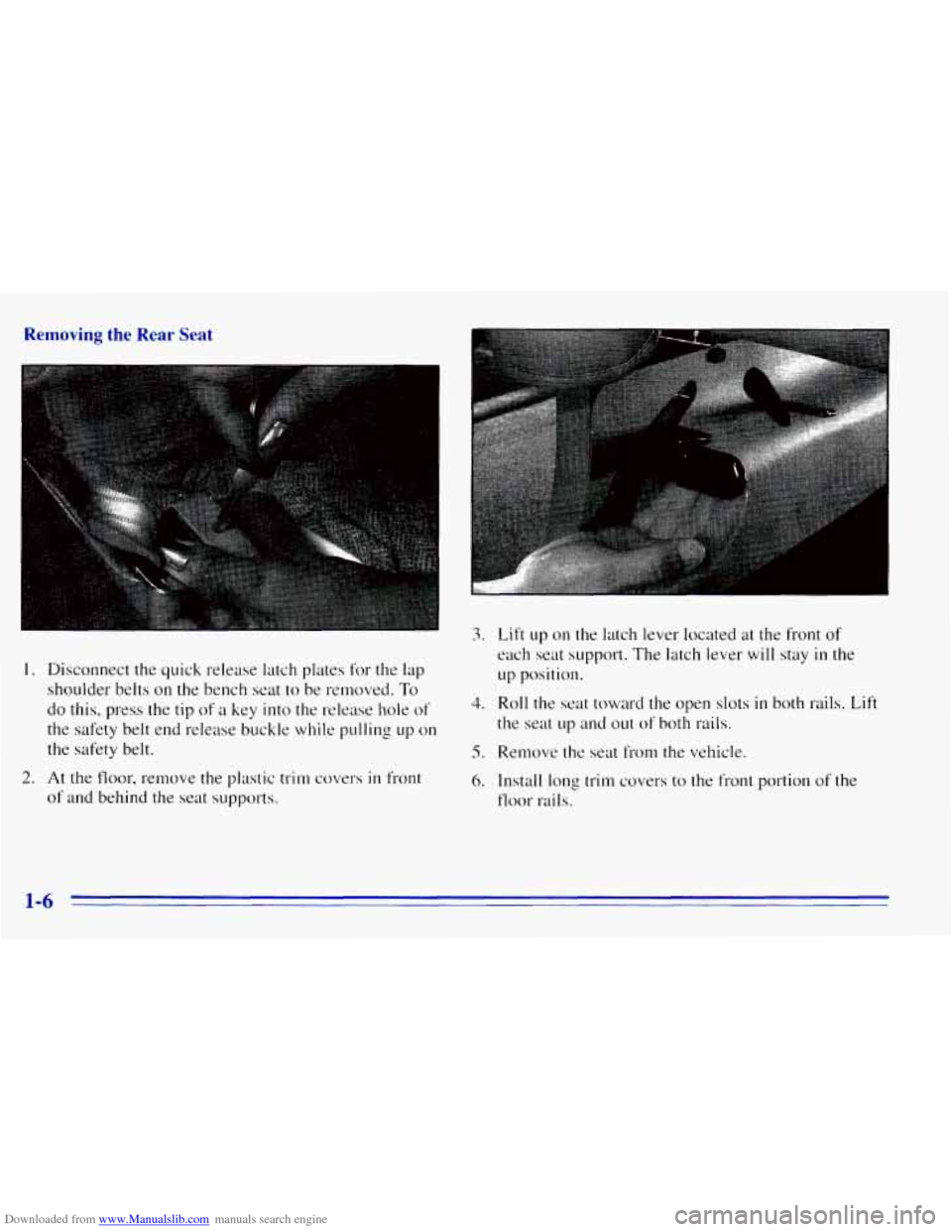
Downloaded from www.Manualslib.com manuals search engine Removing the Rear Seat
I. Disconnect the quick release latch plates for the lap
shoulder belts
on the bench seat to be removed. To
do this, press the tip of a key into the release hole of
the safety belt end release buckle while pulling
up on
the safety belt.
2. At the floor, remove the plastic trim covers in front
of and behind the seat supports.
3. Lift up on the latch lever located at the front of
each seat support. The latch lever
will stay in the
up position.
4. Roll the scat toward the open slots in both rails. Lift
the seat up and out of both rails.
5. Remove the seat from the vehicle.
6. Install long trim covers to the front portion of the
floor rails.
Page 19 of 376
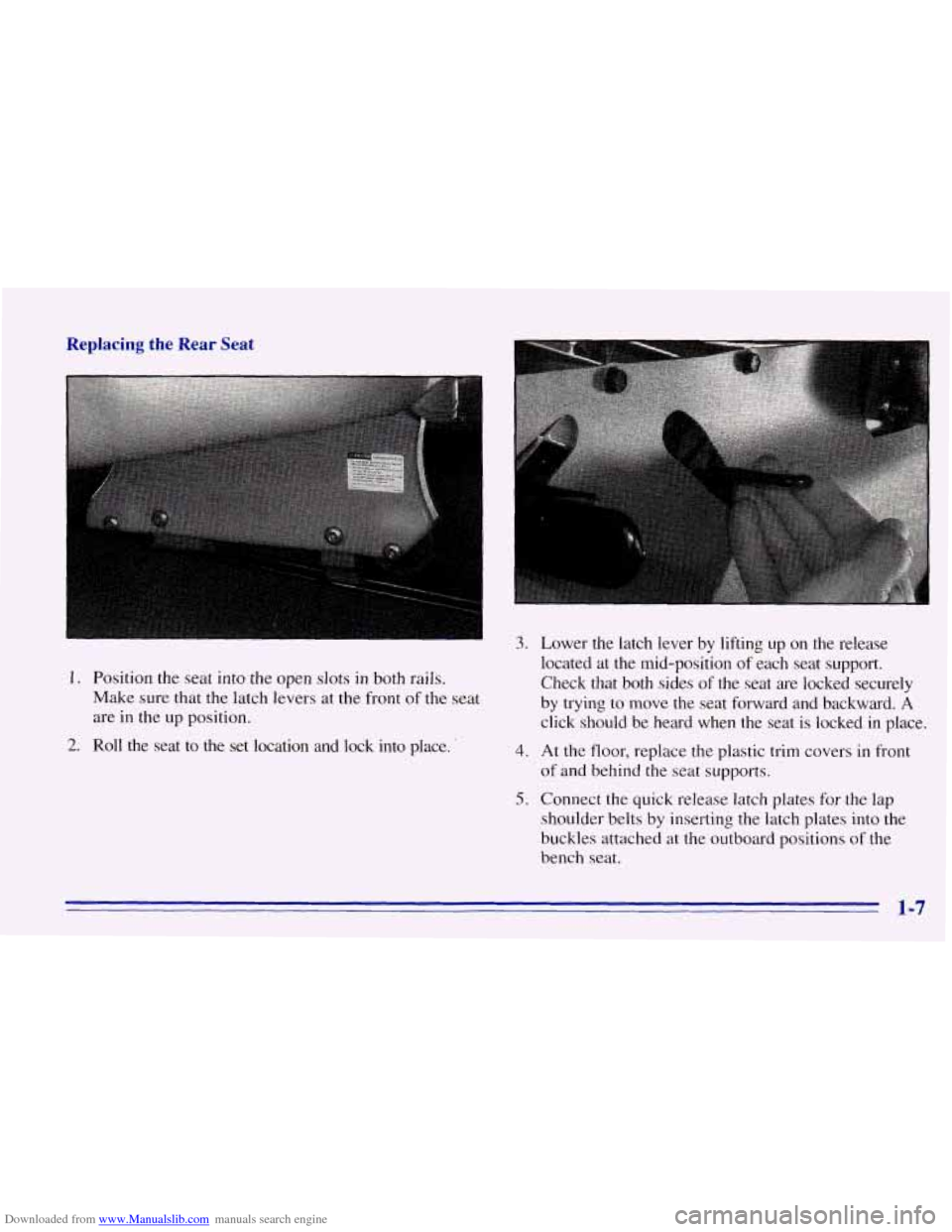
Downloaded from www.Manualslib.com manuals search engine Replacing the Rear Seat
1. Position the seat into the open slots in both rails.
Make sure that
the latch levers at the front of the seat
are in the up position.
2. Roll the seat to the set location and lock into place. '
3. Lower the latch lever by lifting up on the release
located at the mid-position of each seat support.
Check that both sides
of the seat are locked securely
by trying to
move the seat forward and backward. A
click should be heard when the seat is locked in place.
4. At the floor, replace the plastic trim covers in front
of and behind the seat supports.
5. Connect the quick release latch plates for the lap
shoulder belts by inserting the latch plates into the
buckles attached at the outboard positions of the
bench seat.
1-7
Page 20 of 376
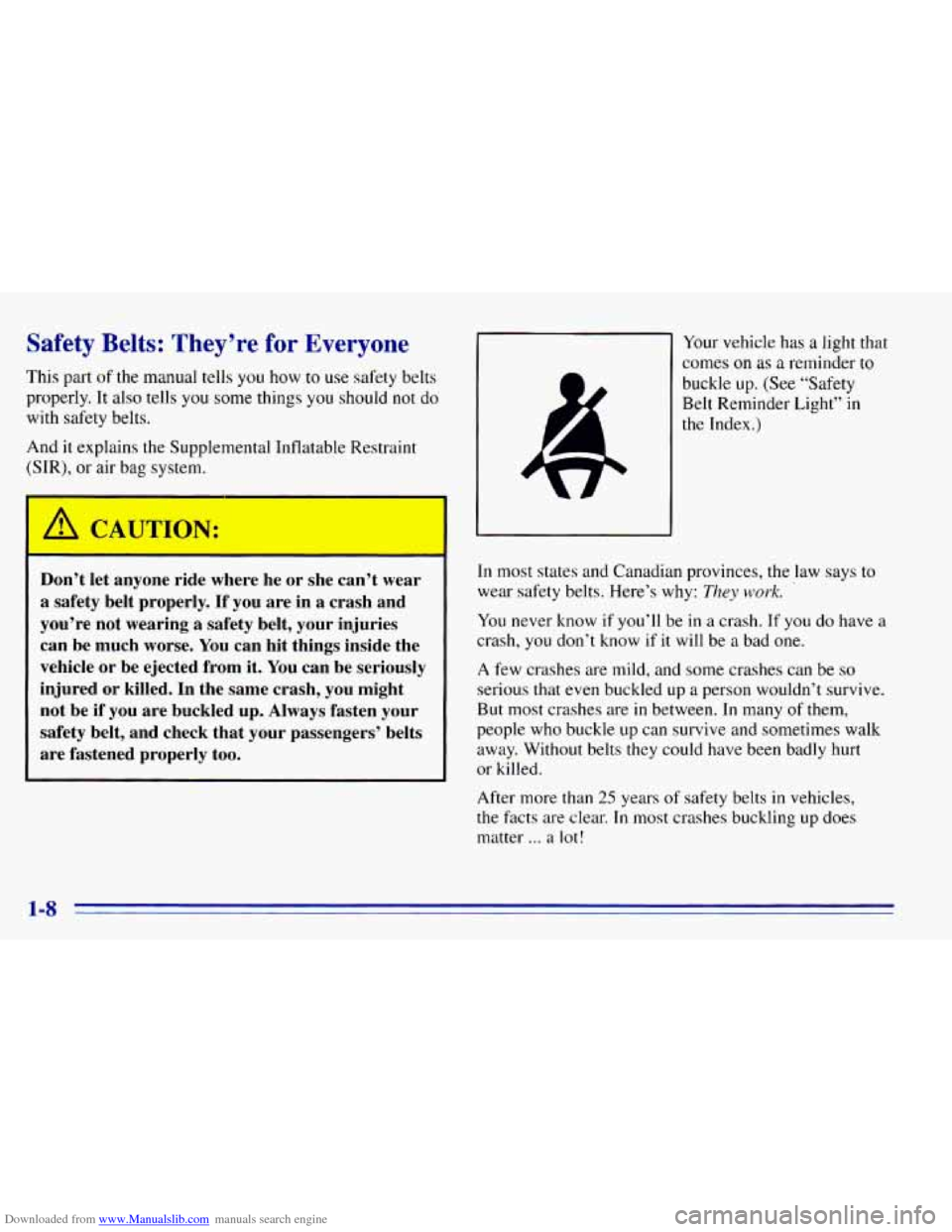
Downloaded from www.Manualslib.com manuals search engine Safety Belts: They’re for Everyone
This part of the manual tells you how to use safety belts
properly. It also tells
you some things you should not do
with safety belts.
And it explains the Supplemental Inflatable Restraint
(SIR),
or air bag system.
I
,/1 CAUTION:
Don’t let anyone ride where he or she can’t wear
a safety belt properly. If you are in a crash and
you’re not wearing a safety belt, your injuries
can be
much worse. You can hit things inside the
vehicle or be ejected from it. You can be seriously
injured or killed. In the same crash,
you might
not be if you are buckled
up. Always fasten your
safety belt, and check that your passengers’ belts
are fastened properly
too.
’
Your vehicle has a light that
comes
on as a reminder to
buckle up. (See “Safety
Belt Reminder Light”
in
the Index.)
In most states and Canadian provinces, the law says to
wear safety belts. Here’s why:
They work.
You never know if you’ll be in a crash. If you do have a
crash,
you don’t know if it will be a bad one.
A few crashes are mild, and some crashes can be so
serious that even buckled up a person wouldn’t survive.
But most crashes are in between.
In many of them,
people who buckle up can survive and sometimes walk
away. Without belts they could have been badly hurt
or killed.
After more than
25 years of safety belts in vehicles,
the facts are clear.
In most crashes buckling up does
matter
... a lot!
1-8